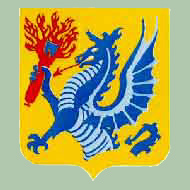
HETHEL HIGHLIGHTS
by Earl L. Zimmerman (389th)
Alright already, I give up. Over the past few years I have had to explain to many how the 389th got the name Sky Scorpion, why our formation ship was called the Green Dragon and why our patch has a blue dragon on it. For the last time gentlemen here is the unofficial story as I knew it.
I first learned of the name Sky Scorpions during the early 1960s when the book Ploesti was published. Up to that time I had never heard of the name although I went over with the original Group and came back with the Group two years later. No one has confirmed it, but I assume the name came from Capt. Kenneth Caldwell's plane "Scorpion".

The photo shows Fearless Caldwell and his crew upon return from Africa. Fearless is front and center, the seedy looking character to his left is John Fino who eventually made Wing Bombardier. Can you believe that?! I wouldn't use anyone in that photo in a mob scene.

Now about the formation ship, the Green Dragon. M/Sgt. Pashal Quackenbush is the original artist of the Dragon painted on the officers club wall. That dragon was green. His original painting of the dragon was blue and during the reunion at Colorado Springs, Pashal donated it to Al Kopp then VP of the 389th. The original now rests in the Library in Norwich. When I had the 389th patches made they were copied from the original, therefore the blue dragon. Anyone out there know who chose the design to paint the Green Dragon?
Which reminds me; I am sound asleep, someone touches me and whispers in my ear, "Zimmerman, you're to fly the Green Dragon on the weather mission." At 2 a.m. it's better than hearing the C.Q. slide his jeep to a halt and charge into the hut, turn on the lights and yell, 'grab your socks etc... all combat men up and at em'. After getting my flimsies, I cycle to the Dragon hardstand and find a skeleton crew plus two nurses in flight gear. We take off, fly to the coast of France and upon returning find we are in the midst of an air raid. I send a message 'Clear base area 13,000 feet' to let the ack ack lads know we are on their side. The two nurses on the flight deck are taking in all of the excitement, sweeping search lights, and tracers flying every direction.
One of the nurses touches me on the shoulder, I remove my headphones and she whispers, 'where is the potty'. Slowly I turn and indicate our forward relief tube behind the pilot's seat. Although she is wearing an oxygen mask I see panic in her eyes. After a few minutes she asks, 'how do you use it'.
Well gentlemen, the training manual does not cover this situation and so I call the pilot on intercom and explain the problem. He advises me to "handle" the situation. About this time the whispering nurse starts to do a slow Cherokee war dance on the flight deck and I decide it's time to take hold of the situation. I deftly maneuver both gals to the waist area and point out our aft tube,. (Shades of Lydon C. Allen article "Relief Tubes" _ "at the time I had no idea relief tubes would be as significant") wish them good luck and depart. Making my way forward I pause on the catwalk and an old English ditty comes to mind. 'My son, my son, it must be done, so out of the window went his bum'. I think to myself, no, she really wouldn't try that. Not at twenty below zero and 200 miles per hour. Later on that morning while in the Ready Room having a cuppa, I overheard a snatch of conversation between our Flight Surgeon Capt. Franz and our pilot. Capt. Franz mentions something about proper appendage.
(Apparently she got frostbite)